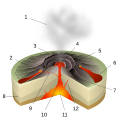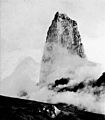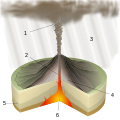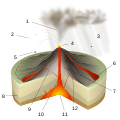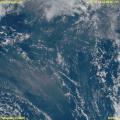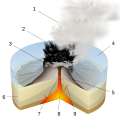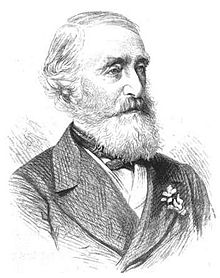Portal:Volcanoes
The Volcanoes portal
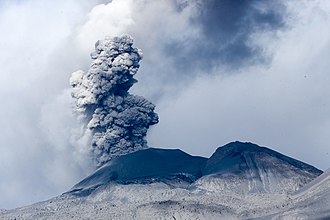
On Earth, volcanoes are most often found where tectonic plates are diverging or converging, and because most of Earth's plate boundaries are underwater, most volcanoes are found underwater. For example, a mid-ocean ridge, such as the Mid-Atlantic Ridge, has volcanoes caused by divergent tectonic plates whereas the Pacific Ring of Fire has volcanoes caused by convergent tectonic plates. Volcanoes can also form where there is stretching and thinning of the crust's plates, such as in the East African Rift and the Wells Gray-Clearwater volcanic field and Rio Grande rift in North America. Volcanism away from plate boundaries has been postulated to arise from upwelling diapirs from the core–mantle boundary, 3,000 kilometers (1,900 mi) deep within Earth. This results in hotspot volcanism, of which the Hawaiian hotspot is an example. Volcanoes are usually not created where two tectonic plates slide past one another.
Large eruptions can affect atmospheric temperature as ash and droplets of sulfuric acid obscure the Sun and cool Earth's troposphere. Historically, large volcanic eruptions have been followed by volcanic winters which have caused catastrophic famines.
Other planets besides Earth have volcanoes. For example, volcanoes are very numerous on Venus. In 2009, a paper was published suggesting a new definition for the word 'volcano' that includes processes such as cryovolcanism. It suggested that a volcano be defined as 'an opening on a planet or moon's surface from which magma, as defined for that body, and/or magmatic gas is erupted.'
This article mainly covers volcanoes on Earth. See § Volcanoes on other celestial bodies and Cryovolcano for more information. (Full article...)
Selected article -
Enceladus is the sixth-largest moon of Saturn and the 19th-largest in the Solar System. It is about 500 kilometers (310 miles) in diameter, about a tenth of that of Saturn's largest moon, Titan. It is mostly covered by fresh, clean ice, making it one of the most reflective bodies of the Solar System. Consequently, its surface temperature at noon reaches only −198 °C (75.1 K; −324.4 °F), far colder than a light-absorbing body would be. Despite its small size, Enceladus has a wide variety of surface features, ranging from old, heavily cratered regions to young, tectonically deformed terrain.
Enceladus was discovered on August 28, 1789, by William Herschel, but little was known about it until the two Voyager spacecrafts, Voyager 1 and Voyager 2, flew by Saturn in 1980 and 1981. In 2005, the spacecraft Cassini started multiple close flybys of Enceladus, revealing its surface and environment in greater detail. In particular, Cassini discovered water-rich plumes venting from the south polar region. Cryovolcanoes near the south pole shoot geyser-like jets of water vapor, molecular hydrogen, other volatiles, and solid material, including sodium chloride crystals and ice particles, into space, totaling about 200 kilograms (440 pounds) per second. More than 100 geysers have been identified. Some of the water vapor falls back as "snow"; the rest escapes and supplies most of the material making up Saturn's E ring. According to NASA scientists, the plumes are similar in composition to comets. In 2014, NASA reported that Cassini had found evidence for a large south polar subsurface ocean of liquid water with a thickness of around 10 km (6 mi). The existence of Enceladus' subsurface ocean has since been mathematically modelled and replicated. (Full article...)Did you know
- ...that Regal Mountain (pictured), an eroded stratovolcano in the Wrangell Mountains, is the third-highest thirteener (a peak between 13,000 and 14,000 feet in elevation) in Alaska?
- ...that Canadian scientist Bill Mathews was a pioneer in the study of subglacial eruptions and volcano-ice interactions in North America?
- ...that thermal vent ecosystems have been discovered in the Aegean Sea, in the caldera of Kolumbo underwater volcano?
- ...that Hawaii's Chain of Craters Road has been blocked repeatedly by lava flows from Kīlauea volcano since it was built in 1928?
- ...that Halemaʻumaʻu Crater in Hawaiʻi Volcanoes National Park erupted explosively on March 19, 2008 for the first time since 1924?
- ... that Bowie Seamount on the British Columbia Coast of Canada is one of the most biologically rich submarine volcanoes on Earth and was an active volcanic island throughout the Last Glacial Period?
- ... that the Lava River Cave in Newberry National Volcanic Monument is the longest known uncollapsed lava tube in Oregon, U.S.?
- ... that the early pre-Columbian site of Xochitecatl in Mexico was abandoned for centuries after the Popocatépetl volcano erupted around 150 AD?
General images
Selected biography -
George Julius Poulett Scrope FRS (10 March 1797 – 19 January 1876) was an English geologist and political economist as well as a Member of Parliament and magistrate for Stroud in Gloucestershire.
While an undergraduate at Cambridge, through the influence of Edward Clarke and Adam Sedgwick he became interested in mineralogy and geology. During the winter of 1816–1817 he was at Naples, and was so keenly interested in Vesuvius that he renewed his studies of the volcano in 1818; and in the following year visited Etna and the Lipari Islands. In 1821 he married the daughter and heiress of William Scrope of Castle Combe, Wiltshire, and assumed her name; and he entered the House of Commons of the United Kingdom in 1833 as MP for Stroud, retaining his seat until 1868.
Meanwhile he began to study the volcanic regions of central France in 1821, and visited the Eifel district in 1823. In 1825 he published Considerations on Volcanos, leading to the establishment of a new theory of the Earth, and in the following year was elected FRS. This earlier work was subsequently amplified and issued under the title of Volcanos (1862); an authoritative text-book of which a second edition was published ten years later. In 1827 he issued his classic Memoir on the Geology of Central France, including the Volcanic formations of Auvergne, the Velay and the Vivarais, a quarto volume illustrated by maps and plates. The substance of this was reproduced in a revised and somewhat more popular form in The Geology and Extinct Volcanos of Central France (1858). These books were the first widely published descriptions of the Chaîne des Puys, a chain of over 70 small volcanoes in the Massif Central. (Full article...)Selected picture
Selected quote
"This ground is hot enough to cook the Sunday roast!"
— John Seach, remarking on his boots melting whilst on the slope of Lopevi Volcano, 2000
Related portals
WikiProjects
Volcanoes topics
Subcategories
Featured work and other approved content

Featured articles: 1980 eruption of Mount St. Helens • 2007–2008 Nazko earthquakes • Amchitka • Armero tragedy • Craters of the Moon National Monument and Preserve • Cerro Azul (Chile volcano) • David A. Johnston • Enceladus (moon) • Geology of the Lassen volcanic area • Io (moon) • Kamaʻehuakanaloa Seamount • Mauna Kea • Mauna Loa • Metacomet Ridge • Mono-Inyo Craters • Mount Cayley volcanic field • Mount St. Helens • Mount Tambora • Nevado del Ruiz • Surtsey • The Volcano (British Columbia) • Triton (moon) • Upper and Lower Table Rock • Volcanism on Io • Volcano (South Park) • Yellowstone National Park
Featured lists: List of volcanoes in Indonesia • List of volcanoes in the Hawaiian – Emperor seamount chain • List of largest volcanic eruptions
Featured pictures: There are currently 43 volcano-related Featured pictures. A full gallery can be seen here.

Good articles: Abyssal plain • Amak Volcano • Anahim hotspot • Axial Seamount • Ben Nevis • Bowie Seamount • Crater Lake • Davidson Seamount • Ferdinandea • Gareloi Volcano • Geyser • Glacier Peak • Hawaii hotspot • Hualālai • Kohala (mountain) • Lake Toba • Minoan eruption • Mount Adams (Washington) • Mount Bailey • Mount Baker • Mount Cleveland (Alaska) • Mount Edziza volcanic complex • Mount Garibaldi • Mount Hood • Mount Kenya • Mount Rainier • Mount Redoubt • Mount Tehama • Mount Thielsen • Mount Vesuvius • Peter I Island • Roxy Ann Peak • Rùm • Sakurajima • Sangay • Silverthrone Caldera • Staffa • Types of volcanic eruptions • Volcanic ash • Weh Island • Wells Gray-Clearwater volcanic field • Yamsay Mountain
Valued pictures: A gallery of volcano-related valued pictures can be seen here.
What you can do

- Add the {{WikiProject Volcanoes}} message box to talk pages of articles within the scope of this project, including appropriate assessments, if needed.
- Add appropriate volcano type categories to articles, and verify the accuracy of any existing categories. See the section "Categorization" below.
- Add {{infobox mountain}} to articles if needed and missing, and add volcano-related fields to existing infoboxes if these are missing.
- Expand volcano articles which are stubs, especially by adding photos and (most importantly) proper references.
- Help improve articles related to Hawaiian and Canadian volcanism by joining the Hawaiian and Canadian workgroups.
- Improve some of the project's most visible articles.
Associated Wikimedia
The following Wikimedia Foundation sister projects provide more on this subject:
-
Commons
Free media repository -
Wikibooks
Free textbooks and manuals -
Wikidata
Free knowledge base -
Wikinews
Free-content news -
Wikiquote
Collection of quotations -
Wikisource
Free-content library -
Wikiversity
Free learning tools -
Wiktionary
Dictionary and thesaurus
































